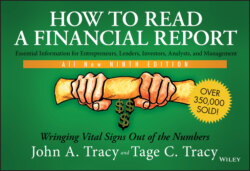How to Read a Financial Report

Реклама. ООО «ЛитРес», ИНН: 7719571260.
Оглавление
John A. Tracy. How to Read a Financial Report
HOW TO READ A FINANCIAL REPORT. WRINGING VITAL SIGNS OUT OF THE NUMBERS
CONTENTS
List of Exhibits
Guide
Pages
PREFACE TO THE NINTH EDITION
1 STARTING WITH CASH FLOWS. Summary of Cash Flows for a Business
What Does Cash Flows Summary Not Tell You?
Profit Is Not Measured by Cash Flows
Cash Flows Do Not Reveal Financial Condition
A Final Note Before Moving On
2 TWO BEDROCK FINANCIAL STATEMENTS. Need for Financial Information
Reporting Profit Performance: The Income Statement
Reporting Financial Condition: The Balance Sheet
3 REPORTING CASH FLOWS. Statement of Cash Flows
Cash Versus Accrual Accounting
Financial Tasks of Business Managers
4 FITTING TOGETHER FINANCIAL STATEMENTS
One Problem in Financial Reporting
Connecting the Dots
5 SALES REVENUE AND ACCOUNTS RECEIVABLE. Exploring One Link at a Time
How Sales Revenue Drives Accounts Receivable
Accounting Issues
6 COST OF GOODS SOLD EXPENSE AND INVENTORY
Holding Products in Inventory Until They Are Sold
Inventory Control
Accounting Issues
7 INVENTORY AND ACCOUNTS PAYABLE. Acquiring Inventory on the Cuff
Accounting Issues
8 OPERATING EXPENSES AND ACCOUNTS PAYABLE. Recording Expenses Before They Are Paid
Accounting Issues
9 OPERATING EXPENSES AND PREPAID EXPENSES. Paying Certain Operating Costs Before They Are Recorded as Expenses
Accounting Issues: Using Prepaid Expenses to Massage the Numbers
10 DEPRECIATION EXPENSE AND PROPERTY, PLANT, AND EQUIPMENT. Overview of Expense Accounting
Depreciation Expense
Accumulated Depreciation and Book Value of Fixed Assets
Book Values and Current Replacement Costs
Intangible Assets
Accounting Issues
11 ACCRUING LIABILITY FOR UNPAID EXPENSES. Recording Accrued Liability for Operating Expenses
Bringing Interest Expense Up to Snuff
Accounting Issues
12 INCOME TAX EXPENSE AND ITS LIABILITY. Taxation of Business Profit
Accounting Issues
13 NET INCOME AND RETAINED EARNINGS, AND EARNINGS PER SHARE (EPS) Net Income into Retained Earnings
Earnings per Share (EPS)
Accounting Issues
14 CASH FLOW FROM OPERATING (PROFIT-SEEKING) ACTIVITIES. Profit Versus Cash Flow from Profit
Changes in Assets and Liabilities That Impact Cash Flow from Operating Activities
The Direct Method for Reporting Cash Flow from Operating Activities
Profit Before the Bottom Line
Accounting Issues
15 CASH FLOWS FROM INVESTING AND FINANCING ACTIVITIES. Completing the Statement of Cash Flows
Seeing the Big Picture of Cash Flows
Accounting Issues
16 FOOTNOTES AND MANAGEMENT DISCUSSIONS
Financial Report Content in Addition to Financial Statements
Financial Statements—Brief Review
Why Footnotes?
Two Types of Footnotes
Management Discretion in Writing Footnotes
Analysis Issues
17 FINANCIAL STATEMENT RATIOS AND ANALYSIS. Financial Reporting Ground Rules
Financial Statement Preliminaries
Extraordinary Gains and Losses
A New Financial Statement
Benchmark Financial Ratios
Current Ratio
Acid Test Ratio (Quick Ratio)
Debt-to-Equity Ratio
Times-Interest-Earned Ratio
Return-on-Sales Ratio
Return on Equity (ROE)
Return on Assets (ROA)
Earnings per Share (EPS)
Price/Earnings (P/E) Ratio
Market Cap
Two Cash Flow Ratios to Chew On
Final Comments
18 FINANCIAL ENGINEERING. What Financial Engineering Is Not
What Financial Engineering Is
Common Types of Financial Engineering
Final Word
19 CPAs AND FINANCIAL REPORTS
Certified Public Accountant (CPA)
From Preparation to Audit of Financial Reports by CPAs
Why Audits?
Do Auditors Discover Financial Reporting Fraud?
20 BASIC QUESTIONS, BASIC ANSWERS
When You Buy Stock Does the Company Get Your Money?
Are Financial Reports Reliable?
Are Some Financial Statements Misleading and Fraudulent?
Should You Take the Time to Compute Financial Statement Ratios?
Why Read Financial Statements, Then, If You Won’t Find Information That Has Been Overlooked by Others?
The Financial Statements and Footnotes of Large Public Companies Would Take Several Hours to Read Carefully: What’s the Alternative?
Is There a Basic Test to Gauge a Company’s Financial Performance?
Do Financial Statements Report the Truth, the Whole Truth, and Nothing but the Truth?
Does Its Financial Report Explain the Basic Profit-Making Strategy or Profit Model of a Business?
Does the Market Price of a Public Company’s Stock Shares Depend Directly and Only on the Information Reported in Its Financial Statements?
Does the Balance Sheet of a Private Business Tell the Market Value of the Business?
Do Books on Investing and Personal Finance Refer to Financial Statements?
A Very Short Summary
ABOUT THE AUTHORS
INDEX. A
B
C
D
E
F
G
H
I
L
M
N
O
P
Q
R
S
T
U
W
WILEY END USER LICENSE AGREEMENT
Отрывок из книги
Ninth edition
JOHN A. TRACY AND TAGE C. TRACY
.....
The left side of the balance sheet lists assets. The right side of the balance sheet first lists the liabilities of the business, which have a higher-order claim on the assets. The sources of ownership (equity) capital in the business are presented below the liabilities. This is to emphasize that the owners or equity holders in a business (the stockholders of a business corporation) have a secondary and lower-order claim on the assets—after its liabilities are satisfied.
Roughly speaking, a balance sheet lists assets in their order of nearness to cash. Cash is listed first at the top of the assets. Next, receivables that will be collected in the short run are listed, and so on down the line. (In later chapters, we say much more about the cash characteristics of different assets.) Liabilities are presented in the sequence of their nearness to payment. (We discuss this point as we go along in later chapters.)
.....